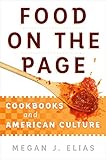Food on the Page : Cookbooks and American Culture / Megan J. Elias.
Material type: TextPublisher: Philadelphia : University of Pennsylvania Press, [2017]Copyright date: ©2017Description: 1 online resource (304 p.) : 10 illusContent type:
TextPublisher: Philadelphia : University of Pennsylvania Press, [2017]Copyright date: ©2017Description: 1 online resource (304 p.) : 10 illusContent type: - 9780812249170
- 9780812294033
- 641.300973 23
- TX644
- online - DeGruyter
- Issued also in print.
| Item type | Current library | Call number | URL | Status | Notes | Barcode | |
|---|---|---|---|---|---|---|---|
 eBook
eBook
|
Biblioteca "Angelicum" Pont. Univ. S.Tommaso d'Aquino Nuvola online | online - DeGruyter (Browse shelf(Opens below)) | Online access | Not for loan (Accesso limitato) | Accesso per gli utenti autorizzati / Access for authorized users | (dgr)9780812294033 |
Frontmatter -- Contents -- Introduction. Words About Food -- Chapter 1. The Best-Fed People in the World: American Cookbooks in the Nineteenth Century -- Chapter 2. An Appetite for Innovation: Cookbooks Before the Second World War -- Chapter 3. Gourmet Is a Boy: Midcentury Cookbooks and Food Magazines -- Chapter 4. Mastering the Art of American Cooking: Julia Child and American Cookbooks -- Chapter 5. Oppositional Appetites: Cookbooks and the Counterculture in the 1960s and 1970s -- Chapter 6. The Palate of Personality: Chefs and Cookbooks at the End of the Twentieth Century -- Chapter 7. Origin Stories: A New Discourse in Twenty-First-Century Cookbooks -- Epilogue. What Should We Read for Dinner? -- Notes -- Selected Bibliography -- Index -- Acknowledgments
restricted access online access with authorization star
http://purl.org/coar/access_right/c_16ec
What is American food? From barbecue to Jell-O molds to burrito bowls, its history spans a vast patchwork of traditions, crazes, and quirks. A close look at these foods and the recipes behind them unearths a vivid map of American foodways: how Americans thought about food, how they described it, and what foods were in and out of style at different times.In Food on the Page, the first comprehensive history of American cookbooks, Megan J. Elias chronicles cookbook publishing from the early 1800s to the present day. Following food writing through trends such as the Southern nostalgia that emerged in the late nineteenth century, the Francophilia of the 1940s, countercultural cooking in the 1970s, and today's cult of locally sourced ingredients, she reveals that what we read about food influences us just as much as what we taste.Examining a wealth of fascinating archival material-and rediscovering several all-American culinary delicacies and oddities in the process-Elias explores the role words play in the creation of taste on both a personal and a national level. From Fannie Farmer to The Joy of Cooking to food blogs, she argues, American cookbook writers have commented on national cuisine while tempting their readers to the table. By taking cookbooks seriously as a genre and by tracing their genealogy, Food on the Page explains where contemporary assumptions about American food came from and where they might lead.
Issued also in print.
Mode of access: Internet via World Wide Web.
In English.
Description based on online resource; title from PDF title page (publisher's Web site, viewed 26. Aug 2020)


